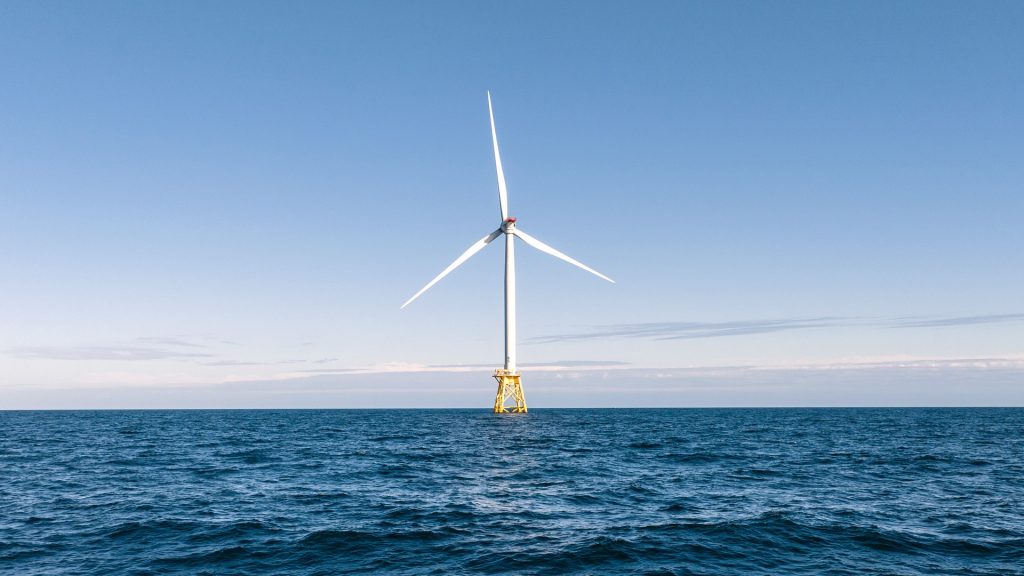Offshore wind runs aground facing Trump policies, sinking public opinion

Offshore wind in New Jersey is on life support, and Bob Stern wants to pull the plug. An engineer turned activist, Stern is pressuring the Trump administration to double down on its actions targeting the offshore wind industry.
Following the proposal of Atlantic Shores, a major offshore wind project located near his home, Stern started the nonprofit Save Long Beach Island in 2021. The group comprises more than 10,000 residents who oppose the project that would have erected 200 wind turbines in federal waters 10-20 miles offshore.
In 2024, after actively voting for Democrats for most of his life, Stern sat out of the presidential election. He isn’t a supporter of President Donald Trump. However, he couldn’t stomach the Biden administration’s embrace of offshore wind, which Stern said would harm the local environment and natural beauty of the coast, while doing little to lower global carbon emissions.
“This is an issue that for many people, really evokes a strong emotional response,” Stern told Straight Arrow News, adding that the beach three blocks from his home is “the only place I can really relax.”
Atlantic Shores is now dormant. The project is one of many across the country struggling to survive a variety of Trump administration policy changes, including quickly phasing out tax incentives and stopping new permits for offshore wind. As a result of those actions, the industry is backpedaling on investments, and advocates worry the United States will lose out on jobs and the benefits of new electricity generation. But opponents say offshore wind isn’t worth the economic cost or potential changes to coastal views and ecosystems.
What was the plan for Atlantic Shores offshore wind?
Originally a joint venture between Shell and EDF Renewables, Atlantic Shores was planned in two phases. The project boasted that it would generate 2.8 gigawatts of electricity, landing it among the largest renewable energy projects in North America.
In October 2024, the Biden administration granted key permits greenlighting the first phase of construction. The project developers said it would bring $1.9 billion to New Jersey’s economy and create 22,000 jobs. Construction was slated to start this year and bring power to the grid by 2029.
Unbiased. Straight Facts.TM
Only 0.2% of global offshore wind energy production is located in North America.

But it didn’t take long for Atlantic Shores to hit choppy waters under the Trump administration.
Shell withdrew from the project at the end of January. The next month, the New Jersey Board of Public Utilities canceled plans to sign an agreement to purchase power from Atlantic Shores, citing Shell’s withdrawal and “uncertainty driven by federal actions and permitting.”
In March, the U.S. Environmental Protection Agency revoked a crucial air permit. By the summer, both Atlantic Shores and the state of New Jersey wanted out. In August, New Jersey regulators revoked their contracts and canceled plans to build new transmission lines that would have integrated offshore wind with the grid.
Atlantic Shores CEO Joris Veldhoven hasn’t given up entirely. When the company asked New Jersey to terminate existing agreements, Veldhoven reportedly said, “this filing marks the closing of a chapter, but not the end for Atlantic Shores.”
What has Trump done to the offshore wind industry?
Atlantic Shores is hardly the only offshore wind project facing delay or cancellation.
On Trump’s first day in office, he issued an executive order to withdraw all federal waters from offshore wind leasing and review all existing federal permits. State waters stretch between three and nine nautical miles offshore before turning into federal waters, which reach 200 nautical miles from shore.
Later in the spring, the Interior Department, led by Secretary Doug Burgum, placed a stop-work order on Empire Shores, a project already underway off the coast of New York.
Work was allowed to resume after New York Gov. Kathy Hochul reportedly agreed on two new gas pipelines being built through the state. Hochul has disputed that any such agreement took place.
Earlier this summer, the Interior Department rescinded maps that outlined federal waters researchers had determined were best suited for offshore wind development. The department also said it would review all offshore wind regulations and stop publishing a list of future lease sales for offshore wind development.
Then in August, the Trump administration issued another stop-work order, this time for Revolution Wind, a project nearing completion off the coast of Rhode Island. Construction on Revolution Wind remains halted, despite being 80% finished.
The Interior Department has directly intervened or asked courts to revoke approvals for additional offshore wind projects along the East Coast.
“Under this administration, there is not a future for offshore wind because it is too expensive and not reliable enough,” Burgum said in September at an energy conference in Italy.
How do New Jersey residents feel about offshore wind?
July polling from Stockton University showed that a majority of New Jersey residents favor building renewable energy over relying on oil and gas. When asked about wind power specifically, only 42% of independents and 21% of Republicans support it. Even among Democrats, support for wind power is 19 points lower than support for solar.
A previous Stockton University poll specifically addressing offshore wind found that opposition has more than doubled since 2019. And in 2024, 20% of independent voters said a candidate’s position on offshore wind would influence their vote “a great deal.”
What are the potential benefits of offshore wind?
Supporters of offshore wind development say the Trump administration’s actions will prevent much-needed power from flowing to the grid and cost the U.S. jobs as investment goes abroad.
“It’s throwing a monkey wrench into an economic development machine,” said David Wooley, a director at the University of California Berkeley’s Goldman School of Public Policy.
Wooley and others who have studied offshore wind told SAN that it would complement existing renewable energy sources on the U.S. grid. Winds over the ocean tend to blow hardest in the evening, at night and during cold months — times when solar power production is nonexistent or minimal. Paired with other resources, including solar, batteries and some conventional power plants, offshore wind is also an ideal energy source for powering large coastal cities, experts said.
“You can’t have a world powered entirely with offshore wind, but it’s a really important player,” Erin Baker, a professor of mechanical and industrial engineering at the University of Massachusetts Amherst, said.
While offshore wind is expensive, experts like Johannes Pfeifenberger, an economist with the consulting firm Brattle Group, say costs will decrease if further investments are made in the industry. Those investments will continue to be made — but not in the U.S., he said.
According to data from the Global Wind Energy Council, North America accounts for only 0.2% of total offshore wind capacity. More than half of all offshore wind is powering China, while about 45% is built off the coast of European countries.
The economies of scale translate to considerably lower costs across the Atlantic and Pacific oceans compared to the U.S. In 2024, offshore wind produced in China cost 5.5 cents per kilowatt-hour, according to a report from the International Renewable Energy Agency. In Europe, producing a kilowatt-hour of electricity from offshore wind costs 8 cents, while in the U.S., it costs more than 12 cents per kilowatt-hour.
“The hope was that by developing offshore wind in the U.S., we could see the sort of 40 to 60% cost reductions over time that Europe and China have already achieved,” Pfeifenberger told SAN.
What do local wind opponents want next?
The Trump administration’s actions are a blow to New Jersey Gov. Phil Murphy’s goal that the state will generate 7,500 megawatts of electricity from offshore wind by 2030 as it looks to rely solely on clean energy by 2050.
But for Stern and some of his Jersey Shore neighbors who felt the Biden-era permitting process was flawed, Trump’s actions have been met with relief.
Stern is not opposed to all offshore wind. He previously served in the Department of Energy’s division overseeing environmental reviews. In that role, Stern said regardless of his personal opinions about a given proposal, he was “obligated to inform the public fully and openly about what would be involved with that and then let the chips fall where they fall.”
Stern said he took issue with the Atlantic Shores project because he felt the public was not fully informed, and the government was determined to push the project through regardless of its consequences. He also said a more open process would benefit wind companies by making their projects less vulnerable to lawsuits and delays.
“The whole process, to me, just doesn’t work well for all parties,” Stern said.
He wants to see the Trump administration go even further by revoking all remaining permits for Atlantic Shores and reforming the permitting process for offshore wind. Stern told SAN he wants to “discourage any new projects from coming in the future.”
Local support for offshore wind
Heidi Yeh is part of the slim majority of New Jersey residents who support offshore wind development. Yeh has studied marine science and is currently the policy director for the Pinelands Preservation Alliance, a local environmental group.
Without naming Save Long Beach Island specifically, Yeh criticized environmental groups she said “were started just for the express purpose of opposing the wind farms,” adding that environmental groups with a longer history in the state “mainly don’t see their views as being aligned with science on this topic.”
Yeh acknowledged that supporters are essentially “waiting out the four years” in hopes of more favorable federal policy, while working to ensure state-level approvals would not become a “bottleneck” in the future.
“We just have such a good coastline to be able to take advantage of offshore wind,” Yeh said. But without investment and favorable policy, she fears “it will be very hard for New Jersey to achieve energy independence.”
NJ governor’s race
This November, New Jersey voters will choose their next governor in a closely-watched election.
With public opinion split sharply along partisan lines, offshore wind has become a factor.
Republican gubernatorial candidate Jack Ciattarelli, a former state assembly member, recently called offshore wind farms one of Democrats’ “worst policy failures” in a social media post. He criticized his Democratic opponent, U.S. Representative Mikie Sherrill, for supporting policies that would “force the construction of wind farms off our Jersey Shore” while pushing to shut down existing power plants within the state.
Polls show Sherrill with the edge, but the race is tight. Ballooning electricity prices remain a key issue, as Republicans attempt to blame the cost on Democrats’ commitment to renewable energy.
Sherrill has proposed freezing electric utility rates, and her campaign website says she supports “building out cleaner and cheaper energy generation” but makes no mention of offshore wind specifically.
The post Offshore wind runs aground facing Trump policies, sinking public opinion appeared first on Straight Arrow News.





